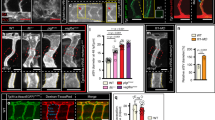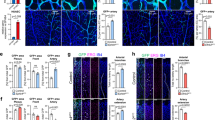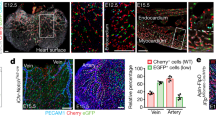Abstract
Within the circulatory system, blood flow regulates vascular remodelling1, stimulates blood stem cell formation2, and has a role in the pathology of vascular disease3. During vertebrate embryogenesis, vascular patterning is initially guided by conserved genetic pathways that act before circulation4. Subsequently, endothelial cells must incorporate the mechanosensory stimulus of blood flow with these early signals to shape the embryonic vascular system4. However, few details are known about how these signals are integrated during development. To investigate this process, we focused on the aortic arch (AA) blood vessels, which are known to remodel in response to blood flow1. By using two-photon imaging of live zebrafish embryos, we observe that flow is essential for angiogenesis during AA development. We further find that angiogenic sprouting of AA vessels requires a flow-induced genetic pathway in which the mechano-sensitive zinc finger transcription factor klf2a5,6,7 induces expression of an endothelial-specific microRNA, mir-126, to activate Vegf signalling. Taken together, our work describes a novel genetic mechanism in which a microRNA facilitates integration of a physiological stimulus with growth factor signalling in endothelial cells to guide angiogenesis.
This is a preview of subscription content, access via your institution
Access options
Subscribe to this journal
Receive 51 print issues and online access
$199.00 per year
only $3.90 per issue
Buy this article
- Purchase on Springer Link
- Instant access to full article PDF
Prices may be subject to local taxes which are calculated during checkout




Similar content being viewed by others
References
Yashiro, K., Shiratori, H. & Hamada, H. Haemodynamics determined by a genetic programme govern asymmetric development of the aortic arch. Nature 450, 285–288 (2007)
Adamo, L. et al. Biomechanical forces promote embryonic haematopoiesis. Nature 459, 1131–1135 (2009)
Gimbrone, M. A. Jr, Topper, J. N., Nagel, T., Anderson, K. R. & Garcia-Cardena, G. Endothelial dysfunction, hemodynamic forces, and atherogenesis. Ann. NY Acad. Sci. 902, 230–239, discussion 239–240 (2000)
le Noble, F., Klein, C., Tintu, A., Pries, A. & Buschmann, I. Neural guidance molecules, tip cells, and mechanical factors in vascular development. Cardiovasc. Res. 78, 232–241 (2008)
Dekker, R. J. et al. Prolonged fluid shear stress induces a distinct set of endothelial cell genes, most specifically lung Kruppel-like factor (KLF2). Blood 100, 1689–1698 (2002)
Parmar, K. M. et al. Integration of flow-dependent endothelial phenotypes by Kruppel-like factor 2. J. Clin. Invest. 116, 49–58 (2006)
Lee, J. S. et al. Klf2 is an essential regulator of vascular hemodynamic forces in vivo. Dev. Cell 11, 845–857 (2006)
Anderson, M. J., Pham, V. N., Vogel, A. M., Weinstein, B. M. & Roman, B. L. Loss of unc45a precipitates arteriovenous shunting in the aortic arches. Dev. Biol. 318, 258–267 (2008)
Isogai, S., Horiguchi, M. & Weinstein, B. M. The vascular anatomy of the developing zebrafish: an atlas of embryonic and early larval development. Dev. Biol. 230, 278–301 (2001)
Serluca, F. C., Drummond, I. A. & Fishman, M. C. Endothelial signaling in kidney morphogenesis: a role for hemodynamic forces. Curr. Biol. 12, 492–497 (2002)
Covassin, L. D., Villefranc, J. A., Kacergis, M. C., Weinstein, B. M. & Lawson, N. D. Distinct genetic interactions between multiple Vegf receptors are required for development of different blood vessel types in zebrafish. Proc. Natl Acad. Sci. USA 103, 6554–6559 (2006)
Nasevicius, A., Larson, J. & Ekker, S. C. Distinct requirements for zebrafish angiogenesis revealed by a VEGF-A morphant. Yeast 17, 294–301 (2000)
Siekmann, A. F. & Lawson, N. D. Notch signalling limits angiogenic cell behaviour in developing zebrafish arteries. Nature 445, 781–784 (2007)
Hellström, M. et al. Dll4 signalling through Notch1 regulates formation of tip cells during angiogenesis. Nature 445, 776–780 (2007)
Sehnert, A. J. et al. Cardiac troponin T is essential in sarcomere assembly and cardiac contractility. Nature Genet. 31, 106–110 (2002)
Vermot, J. et al. Reversing blood flows act through klf2a to ensure normal valvulogenesis in the developing heart. PLoS Biol. 7, e1000246 (2009)
Meadows, S. M., Salanga, M. C. & Krieg, P. A. Kruppel-like factor 2 cooperates with the ETS family protein ERG to activate Flk1 expression during vascular development. Development 136, 1115–1125 (2009)
Wienholds, E. et al. MicroRNA expression in zebrafish embryonic development. Science 309, 310–311 (2005)
Fish, J. E. et al. miR-126 regulates angiogenic signaling and vascular integrity. Dev. Cell 15, 272–284 (2008)
Wang, S. et al. The endothelial-specific microRNA miR-126 governs vascular integrity and angiogenesis. Dev. Cell 15, 261–271 (2008)
Villefranc, J. A., Amigo, J. & Lawson, N. D. Gateway compatible vectors for analysis of gene function in the zebrafish. Dev. Dyn. 236, 3077–3087 (2007)
Nicoli, S., Ribatti, D., Cotelli, F. & Presta, M. Mammalian tumor xenografts induce neovascularization in zebrafish embryos. Cancer Res. 67, 2927–2931 (2007)
Westerfield, M. The Zebrafish Book (Univ. of Oregon Press, 1993)
Siekmann, A. F., Standley, C., Fogarty, K. E., Wolfe, S. A. & Lawson, N. D. Chemokine signaling guides regional patterning of the first embryonic artery. Genes Dev. 23, 2272–2277 (2009)
Lawson, N. D., Vogel, A. M. & Weinstein, B. M. sonic hedgehog and vascular endothelial growth factor act upstream of the Notch pathway during arterial endothelial differentiation. Dev. Cell 3, 127–136 (2002)
Rhodes, J. et al. Interplay of Pu.1 and Gata1 determines myelo-erythroid progenitor cell fate in zebrafish. Dev. Cell 8, 97–108 (2005)
Parsons, M. J. et al. Notch-responsive cells initiate the secondary transition in larval zebrafish pancreas. Mech. Dev. 126, 898–912 (2009)
Covassin, L. D. et al. A genetic screen for vascular mutants in zebrafish reveals dynamic roles for Vegf/Plcg1 signaling during artery development. Dev. Biol. 329, 212–226 (2009)
Roman, B. L. et al. Disruption of acvrl1 increases endothelial cell number in zebrafish cranial vessels. Development 129, 3009–3019 (2002)
Kwan, K. M. et al. The Tol2kit: a multisite gateway-based construction kit for Tol2 transposon transgenesis constructs. Dev. Dyn. 236, 3088–3099 (2007)
Acknowledgements
We would like to thank B. Roman, V. Ambros and C. Sagerstrom for critical review of the manuscript. We thank J.-N. Chen for providing the Tg(kdrl:egfp)la116 zebrafish line. We appreciate the assistance of T. Stork and M. Freeman for help in performing laser assisted microsurgery. We also thank C. Grabher for the gift of gata1 morpholino. We are grateful to M. Beltrame for providing the cdh5 plasmid and T. Smith and S. Sheppard for technical assistance. We thank M. Green and N. Wajapeyee for the Ras-transformed NIH3T3 cell line. This work was supported in part by grants from the National Heart, Lung, and Blood Institute and National Cancer Institute (N.D.L.). The Bioimaging Group (C.S. and K.E.F.) is a core resource supported by a Diabetes Endocrinology Research Center (DERC) grant DK32520 from the National Institute of Diabetes and Digestive and Kidney Diseases. N.D.L and K.E.F are members of the UMass DERC (DK32520). We apologize to researchers whose work we were unable to cite due to space constraints.
Author Contributions S.N. designed and carried out all experiments, analysed data and wrote the paper. C.S. and K.E.F. performed two-photon imaging. P.W. and A.H. developed and provided the miRNA transgenic expression vector. N.D.L constructed the miRNA sensor vector, designed experiments, analysed data and wrote the paper.
Author information
Authors and Affiliations
Corresponding author
Ethics declarations
Competing interests
The authors declare no competing financial interests.
Supplementary information
Supplementary Information
This file contains Supplementary Figures 1-12 with legends, Supplementary Tables 1-3 and legends for Supplementary Movies 1-11. (PDF 9741 kb)
Supplementary Movie 1
This movie shows wild type Tg(kdrl:egfp)la116 embryo imaged by 2-photon microscopy (see Supplementary information file for full legend). (MOV 5805 kb)
Supplementary Movie 2
This movie shows wild type Tg(kdrl:egfp)la116 embryo imaged by 2-photon microscopy (see Supplementary information file for full legend). (MOV 3239 kb)
Supplementary Movie 3
This file contains a video of aortic arch circulation in a wild type embryo at 57 hpf (see Supplementary information file for full legend). (MOV 6983 kb)
Supplementary Movie 4
This file contains a video of aortic arch circulation in a wild type embryo at 65 hpf (see Supplementary information file for full legend). (MOV 2992 kb)
Supplementary Movie 5
This movie shows wild type Tg(kdrl:egfp)la116 embryo treated with BDM beginning at 46 hpf and imaged by 2-photon microscopy (see Supplementary information file for full legend). (MOV 2371 kb)
Supplementary Movie 6
This movie shows wild type Tg(kdrl:egfp)la116 embryo treated with Tricaine beginning at 46 hpf and imaged by 2-photon microscopy (see Supplementary information file for full legend). (MOV 2010 kb)
Supplementary Movie 7
This movie shows wild type Tg(fli1a:negfp)y7 embryo (see Supplementary information file for full legend). (MOV 3406 kb)
Supplementary Movie 8
This movie shows wild type Tg(fli1a:negfp)y7 embryo treated with Tricaine (see Supplementary information file for full legend). (MOV 6062 kb)
Supplementary Movie 9.
This file contains a video of aortic arch circulation in an embryo injected with 11 ng klf2a Morpholino at 65 hpf (see Supplementary information file for full legend). (MOV 2651 kb)
Supplementary Movie 10
This file contains a video of aortic arch circulation at 60 hpf in an embryo injected with 20 ng of miR-126 Morpholino hpf (see Supplementary information file for full legend). (MOV 4354 kb)
Supplementary Movie 11
This movie shows Tg(kdrl:egfp)la116 embryo injected with 20 ng of miR-126 Morpholino hpf and imaged by 2-photon microscopy (see Supplementary information file for full legend). (MOV 4248 kb)
Rights and permissions
About this article
Cite this article
Nicoli, S., Standley, C., Walker, P. et al. MicroRNA-mediated integration of haemodynamics and Vegf signalling during angiogenesis. Nature 464, 1196–1200 (2010). https://doi.org/10.1038/nature08889
Received:
Accepted:
Published:
Issue Date:
DOI: https://doi.org/10.1038/nature08889
This article is cited by
-
Fetal pulmonary hypertension: dysregulated microRNA-34c-Notch1 axis contributes to impaired angiogenesis in an ovine model
Pediatric Research (2023)
-
Characterization of pulmonary vascular remodeling and MicroRNA-126-targets in COPD-pulmonary hypertension
Respiratory Research (2022)
-
Molecular and genetic mechanisms in brain arteriovenous malformations: new insights and future perspectives
Neurosurgical Review (2022)
-
Molecular characterization of atherosclerosis in HIV positive persons
Scientific Reports (2021)
-
Impairing flow-mediated endothelial remodeling reduces extravasation of tumor cells
Scientific Reports (2021)
Comments
By submitting a comment you agree to abide by our Terms and Community Guidelines. If you find something abusive or that does not comply with our terms or guidelines please flag it as inappropriate.



